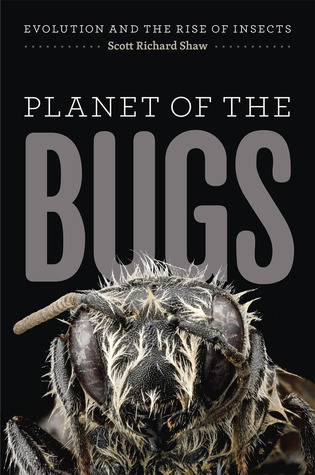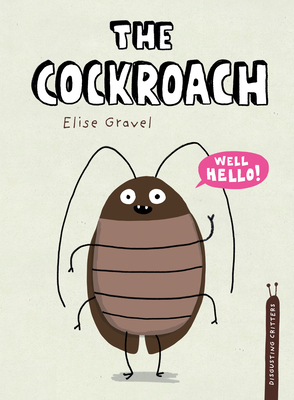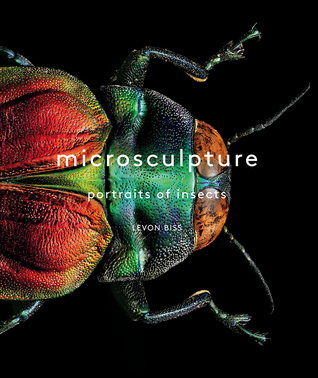
From our viewpoint, it’s probably easy to think we reside on a planet dominated by people, but Scott Shaw makes a good case to consider that we actually reside on a Planet of the Bugs! Shaw introduces us to insect evolution through the eras, describing how environmental & predation pressures played a part in how insects evolved, steadily moving forward and proliferating on their balanced set of 6 legs (for the most part). While I’m not huge on bugs – you can find me doing the hunched shoulders & slinking away manoeuvre throughout the summer when insects abound – this was a fun and informative journey to go on, learning about the advent of exoskeletons, how insects have taken over tiny and tinier ecological niches (how’s laying an egg only in a mature specimen of another insect sound for niche housing?) with different types of parasitism*, and more!
For anyone who has a deep dislike or fear of insects, here’s one way to learn more about them in a more multifaceted way and maybe discover something incredibly cool about them that will make them more approachable. (Or perhaps the bugs approaching you isn’t the issue so much as getting them to leave you alone?) Some other really cool items we carry are the Nature Backpacks, including one with a Creepy, Crawly Critters theme, that can help you get outside and explore the outdoors!
*Parasitism is such a fascinating topic! Wasps, fungi(!), and more evolving to use other organisms as an integral part of their life cycle is just absolutely incredible. Here are some titles on parasitism to check out if you want to learn more: The Wasp that Brainwashed the Caterpillar by Matt Simon, This is Your Brain on Parasites by Kathleen McAuliffe, Plight of the Living Dead, also by Matt Simon, and Parasites by Rosemary Drisdelle.
It’s evident Shaw holds insects in high regard, and his enthusiasm for the subject carries through, knocking down our human-centric biases in the ways geological times are named and reframing our perspective to see it from a bug’s POV (though he does note how inaccurate A Bug’s Life was…), examining their ecological importance and what we stand to lose by continuing to encroach upon and destroy the delicate balance that are their homes. For all that, it did strike me that Shaw seemed to carry this further than I’d consider entirely reasonable, when he posits the inevitability of insect evolution, beyond this planet and into other ones if we ever do find life on them. Then again, the possibility must exist that what Shaw calls his “buggy hypothesis” might be true, too. Either way, who knows, you might come away from Planet of the Bugs having a new appreciation for all the history in its lineage the next time you see a silverfish, earwig, or house centipede in your home! 😉
For younger readers, we’ve also got Elise Gravel’s series of creepy-crawly slimy critters, Disgusting Critters/Petits dégoûtants, that introduce us to creatures like cockroaches, head lice, and toads in all their wondrous complexities, so we learn to, if not love, then at least appreciate and respect them and all that they are.

Personally, I love Gravel’s illustrations and tone, introducing each of these “disgusting” critters as pretty adorable and friendly creatures, I think, that deserve a bit more thought and consideration than their real-life counterparts might inspire in our superficial selves with their less adorable forms. Besides bringing more complexity to what we otherwise term disgusting, we can also take a look at the ways in which the creatures we typically think are beautiful can also be… kinda gross, for example in Butterflies are Pretty… Gross! by Rosemary Mosco, illustrated by Jacob Souva (not yet owned). The aim here is most definitely not to try to make you avoid and fear both the aesthetically pleasing and the more unfamiliar creatures, so much as really highlight the ways in which all creatures have their place in the world and their own good and bad things about them (which might be good or bad for us, but not for them or even maybe not for other critters): for example, it’s not really clear what face mites are doing on our faces, but we seem to cohabit with them just fine for the most part! On the other hand, bunny rabbits may be cute, but they also eat their own poop (or, well, not their poop exactly, but cecotropes, which come out their anus and allow them to reabsorb vitamins and nutrients that weren’t absorbed the first time through their digestive tract – this is similar to how cows chew their cud. See? Once you understand it more, it’s not so gross!). Or have you thought about how chicken eggs come out the same hole as their waste products (the cloaca)? Spiders can be kind of scary, but think about your house spider paying rent by capturing its prey: other insects you’d probably prefer not to have in your house! So let me leave you with this: the world is not black and white, and there are so many shades of grey in between to explore and learn more about if only we let ourselves be curious!
For more titles in our collection to deepen your understanding of (or just aesthetic appreciation of and respect for) insects, check out some of the following!
- Microsculpture: Portraits of Insects from the Collections of the Oxford University of Natural History by Levon Bliss
- The Anatomy of Insects & Spiders by Claire Beverley
- House Guests, House Pests by Richard Jones
- Bug Music: How Insects Gave Us Rhythm and Noise by David Rothenberg
- Garden Insects of North America by Whitney Cranshaw
